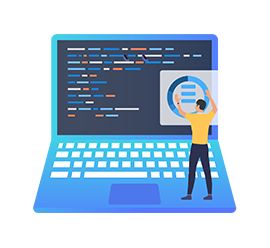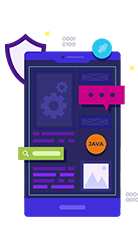August 21, 2019 | The UXer’s design hacks to improve product success

The UXer’s design hacks to improve product success
The UX/UI field is rapidly growing, and the number of agencies that are competing in the marketplace seems to increase by the day. We know that a poorly designed UI can make a person abandon product usage in just a few seconds after a start. That is why it’s so crucially important to make sure that the user experience of your customers is of excellent quality. By working on UI/UX of a product, we make your user’s life easier.
Nothing serves better to communicate the functionality of a web or a mobile application than the User Interface. And there is no other way to make your user satisfied than to ensure that the interaction with your product is enjoyable.
At Bhadani, we have profound knowledge about user interface and user experience. We are creating an intuitive and memorable digital experience. The result of our professional UI/UX services will satisfy your business objectives and user needs. Till now, we’ve completed many of the UI/UX projects for the clients from several distinctive industry verticals. Our human-centered design approach enhances your user engagements for your Business. And we are ready to start working on UI/UX for your business goals with elegant UI and UX solutions.
What IP Media Provides– Wire-frames & Mock-up Prototypes
In this phase of the design process, we move from simple wire-frames, showing the general layout of the client’s software solution, to full-blown, clickable prototypes, narrowing down specific advantages of different aspects of each design.
We follow all the critical elements of excellent UX design to boost product success
We believe that UX is not just creating prototypes rather it organizes your project codebase and bug-free handoff for designers. As per usual, many native app designs stand out for their simplicity, and we haven’t forgotten web interfaces for desktop and responsive UI designs. Whilst the majority of our collection are real-life projects, some are simply concepts just waiting to be brought to life. This is why our focus is purely concentrated on understanding the demands and needs of users and to place these elements into a business context.
Research
Before any design ideas are put on paper, the needs and wants of a product’s potential users and the solution your company will provide must be fully understood. We at BhadaniTech are committed to quality research and analysis before beginning UX/UI design on any project.
Analysis
Of course, once the research is completed, a detailed analysis must be conduction to understand the information gathered. We go through a thorough process of analyzing your product, audience, competition, and monetization. All of this is to ensure that your users’ needs are met, resulting in a successful product.
Design
Once we have reached this stage as a team, we now can create a product that your users can understand using their natural intuition of how things should just work, rather than reading a complicated instruction booklet. Lean UX design is all about activity and getting things done. It’s about getting the right things done so that you can save your time (or your user’s time for that matter). This is where Lean design hacks come up inside the game. So, what are these magical hacks we are discussing and how can you use them in your Lean cycles to create even better products? Here are the few tricks up your sleeve can give your Lean UX design process the power boost it requires. Let’s find out and take a look at a few that you can boost your product’s success.
Create your own Meetup group
Meetup groups can give you direct access to people who are already interested in your product. You know that because they’ll have signed up to attend. If you have a dedicated Meetup with a group of faithful people, you can use them to spread the word for your product and also Another use is testing out your MVP. Creating an MVP is vital if you want to understand where your product fits in the market and, crucially, if people want it.
You might discover through your Meetup group that what you’re working on actually isn’t what people want. This gives you the chance to:
- Drop your idea and pivot in another direction
- Convert your idea into something that your customers want
Use an MVP design:
MVP designs are valuable for speeding up learning, decreasing waste and encouraging iterations. All too often though when we’re in a Lean cycle, we are prone to losing focus or forgetting the bigger picture. You have multiple options available to make your own MVP. Where the MVP Canvas Template intrudes into the process is at the start and to give your MVP creation clarity. The MVP Canvas is a tool that helps you to clarify your product Key assumptions and product strategy. It has 7 sections: Early customers, Unmet needs, Value proposition, Your solution, Unfair advantage, Early Metrics, Key assumptions.
Tell your audience what you’re doing
Why not let people know how hard it is? Using social media platforms like Twitter gives you access to an audience with whom you can share your thoughts, anxieties, fears, and desires. You can build meaningful relationships with other like-minded people as well as form potential business connections. Getting out of the building is important when practicing Lean. Speaking to real people in the real world is valuable. But so is creating that sort of community online by finding out where your customers hang out and talking to them.
Design personas
A user persona is a design representation of your app or website’s userbase. It acts as a benchmark for UX design and development teams to work with to create the optimal user experience. It is an imaginary profile based on the type of people who would be the main users of your app. For UX teams, introducing persona development into the design process helps them learn about the spectrum of goals and needs of their users. A designer’s checklist if you like.
How to create a user persona
Creating a user persona starts with user research. By observing users, UXers can understand their behavior and motivations, and then design accordingly. There are plenty of user research techniques that help UXers capture this information, such as:
- Task analysis (card sorting, first-click testing, etc.)
- Feedback (contextual interviews and focus groups)
- Prototyping (experimenting with ideas before developing them)
Lean design hacks – Conclusion
Working with these hacks will make you a more efficient UX designer. It can be too easy to become overwhelmed by the sheer number of design hacks there. Research them and decide which ones will work for you and which ones just aren’t a good fit.

 .Net
.Net Vue.js
Vue.js Twilio
Twilio Postgre
SQL
Postgre
SQL PHP
PHP React.js
React.js Bootstarp
Bootstarp MySql
MySql Laravel
Laravel Woo
Commerce
Woo
Commerce Firebase
Firebase SQL
Server
SQL
Server Angular
Angular Python
Python ChatBot
ChatBot Wordpress
Wordpress Node.js
Node.js Full
Stack
Full
Stack MongoDB
MongoDB Drupal
Drupal





















